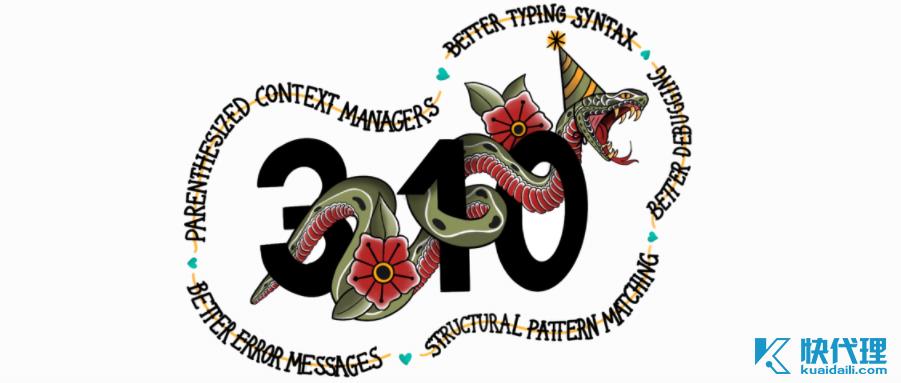Python 3.10 正式发布,新增模式匹配,同事用了直呼真香!
Posted K哥爬虫
tags:
篇首语:本文由小常识网(cha138.com)小编为大家整理,主要介绍了Python 3.10 正式发布,新增模式匹配,同事用了直呼真香!相关的知识,希望对你有一定的参考价值。

关注微信公众号:K哥爬虫,QQ交流群:808574309,持续分享爬虫进阶、JS/安卓逆向等技术干货!
前言
前几天,也就是 10 月 4 日,Python 发布了 3.10.0 版本,什么?3.9 之后居然不是 4.0?(手动狗头)其实龟叔(Guido van Rossum,吉多·范罗苏姆,Python 之父)早在去年 9 月就说了:
- 3.9 之后的版本为 3.10;事实上,它已经存在(在 Github Master 主分支中)。
- 如果有版本 4,从 3 到 4 的过渡更像从 1 到 2,而不是从 2 到 3。

相比 Python 3.9,Python 3.10 主要的新功能如下:

PEP 634 - PEP 636:结构模式匹配
在本次诸多的更新中,Structural Pattern Matching 结构模式匹配,match-case 语句无疑是最让人兴奋的功能,也就类似于 Java、C、Go 等其他语言中的 switch-case 语句,具体用法可以参考:PEP 636
来看一个简单的例子:
def http_error(status):
match status:
case 400:
print("Bad request")
case 404:
print("Not found")
case 418:
print("I'm a teapot")
case _:
print("Something's wrong with the internet")
http_error(418) # I'm a teapot
http_error(500) # Something's wrong with the internet
以上代码中,最后一个 case 中的 _ 并不作为变量名,而表示一种特殊的模式,在前面的 case 中都未命中的情况下,该 case 会是最后的保障,能确保命中,它相当于 Java、C、Go 等语言中的 default 分支:
public class HttpError {
public static void main(String args[]){
int status = 500;
switch(status){
case 400:
System.out.println("Bad request");
case 404:
System.out.println("Not found");
case 418:
System.out.println("I'm a teapot");
default:
System.out.println("Something's wrong with the internet");
}
}
}
// Something's wrong with the internet
match-case 语法支持可变参数 *args 和 **rest。
*args 的用法与 Python 函数中的可变参数是一个用法,允许传入多个参数:
def create_user(command):
match command.split():
case ["quit"]:
quit()
case ["create", user]:
print("create", user)
case ["create", *user]:
for u in user:
print("create", u)
case _:
print("command '{command}' not understood")
create_user("create user1")
create_user("create user2 user3 user4")
# create user1
# create user2
# create user3
# create user4
**rest 会匹配到字典中所有的 key 和 value:
def get_dict(dic):
match dic:
case {**rest}:
print("get dict:", rest)
case _:
print("parameter not understood")
get_dict({"400": "Bad request", "404": "Not found", "418": "I'm a teapot"})
# get dict: {'400': 'Bad request', '404': 'Not found', '418': "I'm a teapot"}
需要注意的是,结构模式匹配在面对不同的对象时,匹配的规则也有所不同。
当匹配对象是列表(list)或者元组(tuple)的时候,需要长度和元素值都匹配,才能命中:
def create_user(param):
match param:
case ("quit"):
quit()
case ("create", user):
print("create", user)
case ("create", *user):
for u in user:
print("create", u)
case _:
print("command '{command}' not understood")
create_user(("create", "user1", "user2"))
# create user1
# create user2
当匹配对象是一个字典(dict)的时候,只要 case 表达式中的 键(key)在字典对象中存在即可命中,以下示例中,很可能会认为会执行第二个 case,但实际上执行了第一个 case:
def if_action(dic):
match dic:
case {"action": action}:
print("action: %s, no object" % action)
case {"action": action, "object": _}:
print("action: %s, have object" % action)
if_action({"action": "create", "object": "user1"})
# action: create, no object
当匹配对象是类对象(class)的时候,匹配的规则和字典(dict)类似,只要对象类型和对象的属性满足条件即可命中,以下示例中,很可能会认为会执行第二个 case,但实际上执行了第一个 case:
class Info:
def __init__(self, name, age):
self.name, self.age = name, age
def get_info(people):
match people:
case Info(name="Bob"):
print("case 1")
case Info(name="Bob", age="20"):
print("case 2")
people = Info(name="Bob", age="20")
get_info(people)
# case 1
PEP 604:新型联合运算符(Union Types)
Python 是个弱类型语言,但是在 Python 3 中支持了定义传参和返回类型的写法:
def test(a: int) -> int:
return a**2
通常一个参数和返回值只能是一个类型,在 C/C++,Java,Go 等静态语言里,不可能返回两种类型,或者传参使用两种类型,但是在 Python 里可以:
def test(a: str or int) -> str or int:
return a**2
这里的 or 写法看着非常不舒服,所以在 Python 3.5 的时候引入了 typing 模块,推荐使用 Uinon 的写法:
from typing import Union
def test(a: Union[str, int]) -> Union[str, int]:
return a**2
在本次 Python 3.10.0 更新中,PEP 604 允许将联合类型(Union Types)写为 X | Y:
def test(a: str | int) -> str | int:
return a**2
新的运算符也可以用作 isinstance() 和 issubclass() 的第二个参数:
print(isinstance(5, int | str)) # True
print(isinstance(None, int | None)) # True
print(issubclass(bool, int | float)) # True
print(isinstance(42, None | str)) # False
PEP 626:错误调试精确到行
在 PEP 626 中,报错提示可以精确到具体行,提示更加详细,在以前的版本中,错误消息一般会指向下一行,而不是实际错误所在的位置,现在可以指向错误代码所在的确切位置。
错误代码示例 1:
li = [1, 2, 3
之前版本报错:
File "D:\\python3Project\\test.py", line 5
^
SyntaxError: unexpected EOF while parsing
Python 3.10 版本报错:
File "D:\\python310Project\\test.py", line 4
li = [1, 2, 3
^
SyntaxError: '[' was never closed
错误代码示例 2:
expected = {"name": "Bob", "age": 20
some_other_code = foo()
之前版本报错:
File "D:\\python3Project\\test.py", line 2
some_other_code = foo()
^
SyntaxError: invalid syntax
Python 3.10 版本报错:
File "D:\\python310Project\\test.py", line 1
expected = {"name": "Bob", "age": 20
^
SyntaxError: '{' was never closed
PEP 618:zip() 可选长度检查
zip() 是 Python 中的内置函数,用于将可迭代的对象作为参数,将对象中对应的元素打包成一个个元组,然后返回由这些元组组成的列表。
在以前的版本中,如果各个迭代器的元素个数不一致,则返回列表长度与最短的对象相同,示例如下:
a = [1, 2, 3]
b = [4, 5, 6]
c = [4, 5, 6, 7, 8]
zipped1 = zip(a, b)
zipped2 = zip(a, c) # 元素个数与最短的列表一致
print([z for z in zipped1]) # [(1, 4), (2, 5), (3, 6)]
print([z for z in zipped2]) # [(1, 4), (2, 5), (3, 6)]
在 PEP 618 中,新增了 strict 参数,设置为 True 时,传入 zip() 的两个可迭代项长度必须相等,否则将抛出 ValueError
a = [1, 2, 3]
b = [4, 5, 6]
c = [4, 5, 6, 7, 8]
zipped1 = zip(a, b, strict=True)
zipped2 = zip(a, c, strict=True)
print([z for z in zipped1])
print([z for z in zipped2])
报错:
[(1, 4), (2, 5), (3, 6)]
Traceback (most recent call last):
File "D:\\python310Project\\test.py", line 8, in <module>
print([z for z in zipped2])
File "D:\\python310Project\\test.py", line 8, in <listcomp>
print([z for z in zipped2])
ValueError: zip() argument 2 is longer than argument 1
BPO-12782:允许带括号的上下文管理器
Python 上下文管理器对于打开/关闭文件、处理数据库连接和很多其他事情都非常有用,在 Python 3.10.0 中,它们的语法将有一点高质量的改进,在 BPO-12782 正式允许带括号的上下文管理器,现在可以用一个 with 语句创建多行,示例如下:
with(
open("text1.txt", encoding="utf-8") as f1,
open("text2.txt", encoding="utf-8") as f2
):
print(f1.read(), f2.read())
PEP 613:显式类型别名
PEP 613 使用 TypeAlias 显式标注类型别名,提高可读性。
以前版本,可以看到,x 很容易被搞混:
x = int
def plus_int(a: x, b: x) -> x:
return a+b
Python 3.10 中,使用 TypeAlias 表明这是个别名,消除歧义:
from typing import TypeAlias
x: TypeAlias = int
def plus_int(a: x, b: x) -> x:
return a+b
性能提升
与所有最新版本的 Python 一样,Python 3.10 也带来了一些性能改进。首先是优化 str(),bytes() 和 bytearray() 构造函数,它们速度提升了 30% 左右,代码摘自 BOP-41334:
$ ./python -m pyperf timeit -q --compare-to=../cpython-release2/python "str()"
Mean +- std dev: [/home/serhiy/py/cpython-release2/python] 81.9 ns +- 4.5 ns -> [/home/serhiy/py/cpython-release/python] 60.0 ns +- 1.9 ns: 1.36x faster (-27%)
$ ./python -m pyperf timeit -q --compare-to=../cpython-release2/python "bytes()"
Mean +- std dev: [/home/serhiy/py/cpython-release2/python] 85.1 ns +- 2.2 ns -> [/home/serhiy/py/cpython-release/python] 60.2 ns +- 2.3 ns: 1.41x faster (-29%)
$ ./python -m pyperf timeit -q --compare-to=../cpython-release2/python "bytearray()"
Mean +- std dev: [/home/serhiy/py/cpython-release2/python] 93.5 ns +- 2.1 ns -> [/home/serhiy/py/cpython-release/python] 73.1 ns +- 1.8 ns: 1.28x faster (-22%)
另一个更值得注意的优化(如果你使用类型注释)是,函数参数及其注释不再在运行时(runtime)计算,而是在编译时计算,这使得创建一个带有参数注释的函数的速度提高了大约 2 倍。
除此之外,Python 核心的各个部分还有更多的优化,你可以在 Python bug tracker 的下列问题中找到更多的细节:BPO-41718、BPO-42927、BPO-43452。
其他改变
- PEP 623:弃用并准备删除 PyUnicodeObject 中的 wstr 成员。
- PEP 612:参数规范变量。
- PEP 632:弃用 distutils 模块,推荐使用 setuptools。
- PEP 644:CPython 的标准库仅支持 OpenSSL 1.1.1 或更新版本。
- PEP 624:删除 Py_UNICODE 编码器 API。
- PEP 597:添加可选的 EncodingWarning。

以上是关于Python 3.10 正式发布,新增模式匹配,同事用了直呼真香!的主要内容,如果未能解决你的问题,请参考以下文章
就在之前10月,Python 3.10 正式发布了,我发现了一个可怕的功能......
就在之前10月,Python 3.10 正式发布了,我发现了一个可怕的功能......